Waveboard 2025 test: All-round waveboard versus radical model - five pairs compared
Surf Testteam
· 26.11.2024






- All-rounder or performance waveboard - these are the differences
- Radical or all-rounder - these board sizes make sense
- What wave level do you have?
- Waveboard type and size - the surf recommendation
- Duotone Grip 3 95 vs Grip 4 99
- Goya Custom Thruster 82 vs Custom Quad 88
- JP-Australia Magic Wave 89 vs Ultimate Wave 93
- Naish Global Quad 75 vs Hookipa Quad 84
- Severne Pyro 87 vs Nano Pro 92
- All 2025 waveboards in the individual test
It often happens that a conversation with a reader leads to an idea for a future test - and this topic was no exception. Specifically, it was about the question of "which waveboard size actually makes sense for a certain weight if you want to equip your personal fleet with one or two boards".
On closer inspection, the answer is not so simple, as most brands offer two wave board models: the "all-rounders" are supposed to offer balanced turning characteristics, while still gliding well and being easy to control in typical Euro wave conditions with currents and cross onshore winds. On the other hand, there are the "performance" boards, which promise maximum turning ability and radicality, at the expense of some gliding power and suitability for the masses - at least that's the theory.
The answer to the question: "Which waveboard size makes sense?" should therefore always be considered against the background of the respective board concept. Specifically: Is it better to surf a performance waveboard with 92 litres instead of an all-rounder with 85 litres, because it glides and turns comparably well - and also offers more safety for dumping? Or does "smaller" always mean "more radical"?
To find the answers, we ordered ten of the latest wave boards in sizes ranging from 75 to 99 litres. We always chose the all-rounders slightly smaller than the supposedly more radical concept of the same brand and ultimately compared the following pairs with each other:
All-rounder or performance waveboard - these are the differences
On average, the performance waveboards, apart from the Nano Pro from Severne, are slightly longer than the all-rounders. However, the differences in the outlines are more striking: typical all-rounders such as the Duotone Grip 3, Naish Global Quad, Goya Custom Thruster or the JP Magic Wave have a more parallel outline, i.e. the nose and tail areas are designed slightly wider, which results in a more parallel edge shape and should allow the boards to carve in a controlled manner. The wider tails should also offer more stability and speed retention in turns.
The performance counterparts Duotone Grip 4, Naish Hookipa Quad, Goya Custom Quad or the JP Ultimate Wave are more rounded, meaning they have narrow tail and bow areas. They also have an average of more curve in the underwater hull in the edge area to support the turning characteristics.
Some details of the waveboards
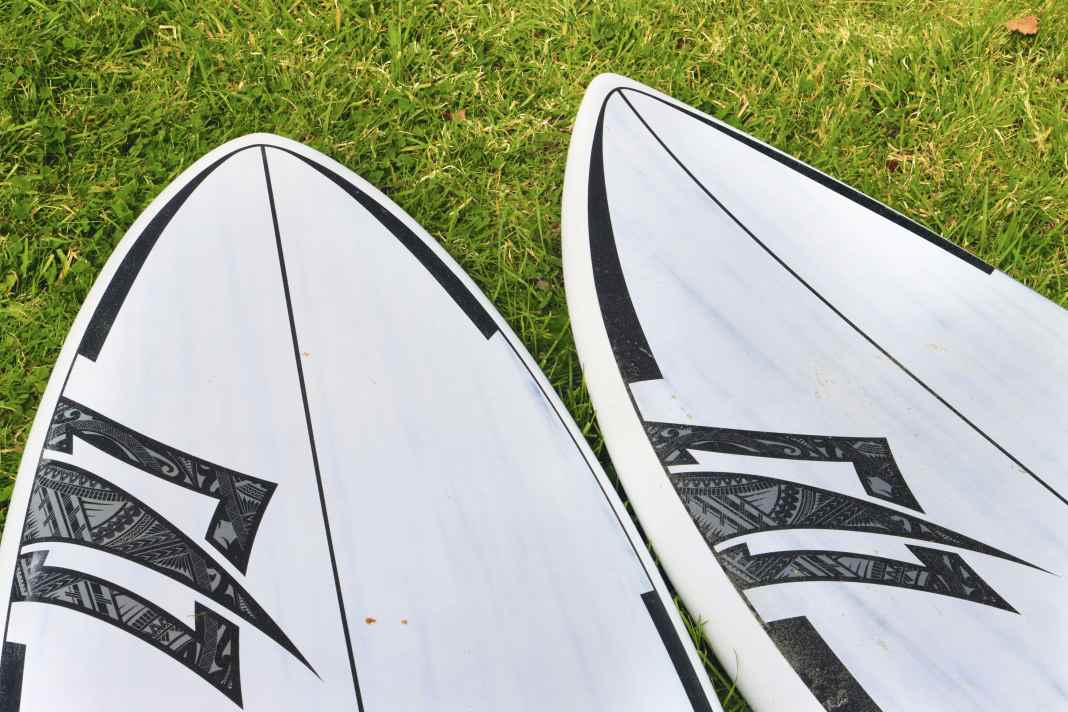





- You can find even more details in the individual tests or in our preview
Radical or all-rounder - these board sizes make sense
We surfed all the boards with several testers weighing between 74 and 92 kilos. We also had the smallest boards ridden by a lightweight guest tester. The aim was to find out where sensible volume ranges end.
It quickly became clear that the right board size cannot be summarised in a single formula, but depends heavily on the rider's ability. Our testers and guest tester Diana Lohoff, who all have a high level in the waves, would all privately choose performance shapes that are easy to turn, but if in doubt, they would choose a size larger. A direct comparison of the board models showed that the turning characteristics depend heavily on the shape and less on the size. Even when powered up with the 4.0 sail at the North Sea spot of Rømø, our 80-kilo testers preferred the 93-litre performance waveboard to the 87-litre all-rounder, because with the radical representatives, assuming the right planing technique, you start to slip comparably early, but can turn more easily and the "perceived" size is actually smaller. Diana got on much better with a performance wave board like the Naish Hookipa Quad 84 than with a 75 all-rounder: "I was surprised at how easily I was able to turn the larger board, even with a 3.3 mm sail. The perceived size was smaller than with the 75 Global Quad, which is a little more moderately tuned."
All-round wave boards with high glide are, leaving aside the personal preferences of the testers, by no means superfluous - as our test also showed. After all, those who rarely surf surf waves benefit immensely from this type of board: the wider tails in combination with a flatter rocker line keep the speed better even in front of moderate waves, which means you often arrive at the wave lip with more speed - and speed is the basic prerequisite for a good cutback. The all-round shapes are also often better suited to jumping, as they accelerate more powerfully on average, run more height and cross white water more easily. The result: you surf more waves, get more jumps - and have more fun in the end.
That's what the surf testers say:
- "7 to 8 litres above my body weight, that's the upper limit for me, with which I can plane as early as possible and still turn the board tightly." (Klaus Twilling)
- "Less volume = more agility - this formula applies less to waveboards than to other board classes." (Fabian Grundmann
- "Choosing a more radical concept one size larger often makes sense." (Marius Gugg)
- "I was surprised at how well boards turn that I thought would be far too big for me." (Guest tester Diana Lohoff)
- "How manoeuvrable a board is depends less on the volume and more on the shape." (Manuel Vogel)
What wave level do you have?
To find the right board type and size, categorise yourself into one of the three "wave levels" and then refer to the table for the specific recommendation for board volume and board type.
Level 1
Are you just learning to surf in the surf or do you rarely have the chance to surf in real surf waves due to a lack of opportunities? Do you also enjoy days without breaking waves, i.e. in flat water or bump & jump conditions? You don't want to surf a lazy cucumber, but want to practise jumping and riding downwind - but with control? Then you need a board that glides effortlessly, goes upwind well, floats easily over white water, jumps well and carries you safely through the bottom turn without parking too quickly. You can find the exact size recommendation in the table.
Level 2
Your focus is clearly on surfing waves, days in flat water are the exception for you? Do you have just as much fun on good Baltic Sea days as you do in crashing North Sea conditions? Do you usually manage wave rides downwind without any major problems and on the way out do you look out for ramps for juicy jumps and first loops? Then both all-round and performance shapes are suitable in principle - see the table for the right sizes.
Level 3
Do you use your wave board 100 per cent in the surf and have a different board for flat water conditions? Do you take good wave days on the Baltic Sea just as well as big North Sea waves and trips to top international spots? Do you ride downwind without any problems, carve your bottom turns with speed and planing over the front foot and have loops as well as radical cutbacks and first wave moves such as takas, lipslides or even 360s in your repertoire? Then you can classify yourself as wave level 3 without batting an eyelid - you can find your board recommendation in the table.
Waveboard type and size - the surf recommendation
Wave level 1
One-board solution
- Board 1: All-round, volume: body weight +5 to 8 litres
Two-board solution
- Board 1: All-round, volume: body weight +0 to 3 litres
- Board 2: All-round, volume: body weight +8 to 10 litres
Wave level 2
One-board solution
- Board 1: All-round, volume: body weight +3 to 5 litres
- Alternative: Performance, volume: body weight +5 to 10 litres
Two-board solution
- Board 1: Performance, volume: body weight +3 to 5 litres
- Board 2: All-round, volume: body weight +8 to 10 litres
Wave level 3
One-board solution
- Board 1: Performance, volume: body weight +0 to 5 litres
Two-board solution
- Board 1: Performance, volume: body weight +/- 2 litres
- Board 2: Performance, volume: body weight +5 to 8 litres
In addition to the recommendation of board type and size, you will find a comparison of the tested board pairs below. Detailed individual descriptions of all models and the technical data can also be found in the individual tests!
Duotone Grip 3 95 vs Grip 4 99
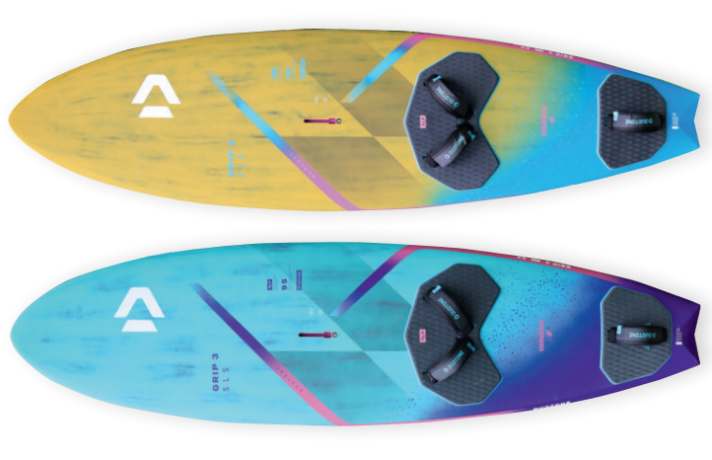
On land
The duel of the giants, at least in terms of volume, is between the two Duotone models. Apart from the fin configuration - the Grip 3 comes as a thruster, the Grip 4 as a quad - the typical differences described above can also be seen in this pair: the Grip 3 is slightly shorter, the nose and tail sections are visibly wider, resulting in a fairly parallel outline. Compared to this, the Grip 4 has significantly more curve around the edges. Both models are equipped with comfortable straps with double screws throughout, and the pads are also well padded and grippy.
To save weight, the mast track is short, but there is still enough scope for individual tuning.
On the water
The Grip 3 planes harmoniously and without a noticeable planing threshold. Thanks to the thruster setup and the slightly wider tail, you can exert good pressure on the fins to get a good angle to the wind and accelerate the board to a top speed suitable for jumping. Even when fully powered up, the Grip 3 is not the kind of board that gives you a lively, free ride, rather the board with its rail-like water position and excellent damping provides absolute comfort. The edge grip is also absolutely convincing, regardless of whether you're jibing on the swell wave or speeding through the bottom turn, the Grip 3 always offers enough grip and control on the edge. If you take the speed out a little or turn the radii more over the back foot, you can also elicit really good turning characteristics from the board, with which moderate surf waves can be expertly carved up. In addition, the Grip 3 holds speed really well in moderate wave conditions, which means you can always arrive at the lip of the wave with enough speed. Only when the waves get powerful or the wind gets strong does it become increasingly difficult to change the radius from wide to tight in order to hit the lip of the wave vertically. Experienced surfers will miss some potential for radical cutbacks and wave moves.
The Grip 4 is also absolutely convincing in the planing duel. Due to the shorter fins and narrower tail compared to the Grip 3, you have to be a little more sensitive when planing and going upwind, but overall the Grip 4 gets up to speed just as quickly and is also very smooth and easy to ride. The forgiving shape quickly takes the edge off choppy waves. Anyone who thinks that waveboards with a volume of almost 100 litres can't be turned tightly should try the Grip 4 - the board edges smoothly and with comparatively little edge pressure. Even at higher speeds - i.e. in front of powerful waves or in stronger winds - the good variability when turning over the front foot is maintained. Pulling through the bottom turn with plenty of steam over the entire edge and then steering tightly and vertically up to the breaking lip - the Grip 4 99 does this at all times. As a result, the board offers experienced riders noticeably more potential for tight cutbacks, slides and wave manoeuvres such as 360s and takas.
Duotone Waveboards - the conclusion
Both boards are good gliders and score with a lot of control over a wide wind range. If you mainly windsurf in moderate surf conditions, but also regularly go out on the water in bump & jump conditions, the Grip 3 is better. Carving over the front foot is much easier with the Grip 4. It is also more variable and radical in larger sizes without being too demanding - a few extra litres of volume don't interfere with this model at all.
Goya Custom Thruster 82 vs Custom Quad 88
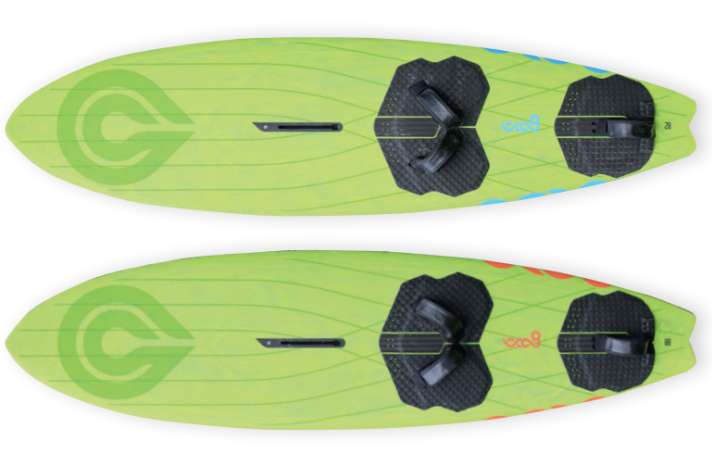
On land
The Goya pair enters the race with a completely new design. US boxes are used and the fins are fixed with an FCS spanner. The fins on the custom thruster are slightly notched at the tips, which should have a positive effect on the twist behaviour and ultimately the grip. Goya double-bolts the soft and comfortable straps at the back and only fixes them with one screw at the front. In terms of the outline, the boards differ only slightly, the dimensions are almost identical. The underwater hull of both models is also characterised by a slight mono-concave in the rear area, which then changes into a slight V with double concaves in the area of the straps. The weights are remarkably low: The Custom Quad 88 weighs in at 6.05 kilos, while the Custom Thruster 82 even breaks the 6-kilo barrier at 5.92 kilos.
On the water
The new Custom Thruster slides effortlessly over the glide threshold with the first sheet in, the board makes a lively, fast impression. When powered up, it hangs lightly and agilely on the foot, but still offers enough control and damping to be able to ride in rough conditions. The lively basic feeling can also be found one-to-one on the wave: whether you are riding short, fast hooks over the back foot or carving wide radii with a lot of planing, the Custom Thruster 82 does everything willingly. It can be edged effortlessly, pulls over the edge with good speed and remains surprisingly variable even in front of powerful waves, so that you can vary the radii well.
It sounded similar when our test crew talked about the Custom Quad 88 after a session. In terms of planing performance, there is virtually no difference between the two test models, only the planing position is more "Quad-like", i.e. the board sits a little more firmly in the water and doesn't glide quite as freely, but a little more like it's on rails. However, the Quad also shows all-round qualities on the wave, where short hooks on small foam rollers can be celebrated as well as fast, powerfully carved turns in front of mast-high breakers. All in all, the Quad offers a little more variability, especially considering that the thruster we tested is one size smaller. Compared to the predecessor model, the Quad now also appears much more manoeuvrable over the back foot and therefore also offers noticeably more potential for moderate surf and short hooks in waist-high Baltic waves.
Goya Waveboards - the conclusion
As similar as the shapes on land, as similar is the performance on the water. Both models cover a wide range of use thanks to good planing performance, balanced turning characteristics and plenty of control. Those who mainly surf typical Euro wave conditions from Heiligenhafen to Hanstholm can make their decision depending on whether they prefer the livelier planing feeling and even more powerful acceleration of the Thruster or whether they prefer the somewhat fuller water position of the Custom Quad instead. The Thruster offers a little more potential in bump & jump and light winds, while the Quad carves a little more smoothly on the edge in big ocean waves despite having a few litres more on its ribs.
JP-Australia Magic Wave 89 vs Ultimate Wave 93
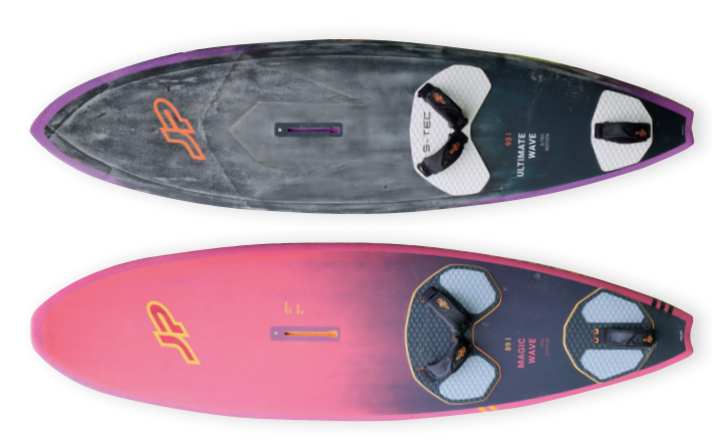
On land
In a direct comparison of the JP models, the Ultimate Wave is around three centimetres longer, but has a rounder outline due to its narrower nose and tail sections. The Ultimate is delivered without fins; we recommend centre fins with a length of 14.5 to 15 centimetres and side fins with a length of 9 to 10 centimetres. The board is manufactured in a lightweight S-Tec construction and is equipped with thin pads. On a positive note, both models are equipped with very good straps, which are also double-fastened with thick screws throughout.
On the water
The magic of the Magic Wave unfolds right from the first sheet in: The model pulls away effortlessly, reaches a very good top speed and combines a lively ride with impressive control. Even when really powered up with the 4.0 sail and in rough conditions, the Magic Wave stoically swallows up the choppy waves and ensures that you can go in search of the first ramp at full speed. Jibes against the swell are smooth and the board scores points for its control on the edge. It prefers medium and wide radii, through which the Magic Wave pulls with plenty of edge grip. The potential to maintain speed in front of unpressurised waves and with little sail pull is also above average. In typical sideonshore conditions - i.e. when the speed on the wave is normally not so high - you can also elicit tight snaps and a degree of turning ability from the board that will satisfy even experienced wave riders. In side- or side-offshore wind and fuelled by small sails, however, the radii seem somewhat limited as soon as you carve over the edge with a lot of planing and speed - this is when the Ultimate Wave comes into its own.
The Ultimate Wave has been tuned much more radically on paper, but - as you notice immediately on the water - it is not a lame wave banana. Compared to the Magic Wave, it tilts a little more when bobbing and you have to load it a little more sensitively when planing, but then the board really gets off the mark. The planing position is not quite as "sporty and free" as that of its stablemate, but conveys that rail-like feeling that is generally attributed to quads. The fact that the Ultimate is in a completely different league when it comes to manoeuvrability becomes clear not only during the first jibe, but of course above all when riding waves. The board can be edged with noticeably less pressure and masters all radii. Carve the bottom turn long and with a lot of rail and then pull up tight and vertically to the wave lip - hardly any other board is as much in its element as the Ultimate Wave. Even with the 3.7 mm sail, the radii remain surprisingly variable. Only in slack wave conditions does the shape require a little more riding skill to get the speed through the bottom turn up to the wave lip.
JP-Australia Waveboards - the conclusion
The two JP boards serve very different target groups on the water. The Magic Wave feels slightly larger in comparison - planing performance and speed level are top, the turning characteristics are quite appropriate for a wave board for the North and Baltic Sea. If you don't necessarily need every litre of volume, you can choose the Magic Wave one size smaller if in doubt.
The Ultimate Wave is no longer as selective as it used to be and opens up its outstanding turning ability to more than just semi-pros. If you skip bump & jump days anyway, ride safely downwind and are looking for a variable turning board just for waves, you can go for the Ultimate Wave without hesitation. Because the turning potential and control are so convincing, even a few extra litres of volume don't bother the Ultimate Wave - if in doubt, the board can definitely be chosen one size bigger.
Naish Global Quad 75 vs Hookipa Quad 84
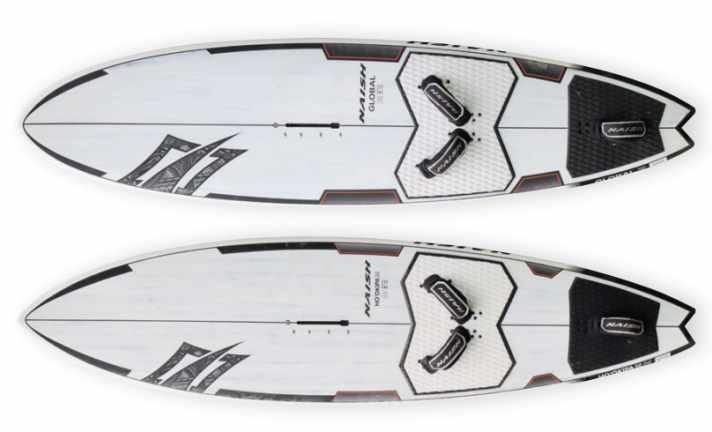
On land
The smallest boards in the test group are both quad fins, but their shapes are very different. The more radical performance model, the Hookipa Quad, is around four centimetres longer, but still appears much more rounded in terms of outline than the all-rounder Global Quad due to its noticeably narrow nose and tail sections. Both boards impress with good features. The comfortable straps are double-bolted throughout and the weights are pleasingly low at 5.87 kilos (Global) and 5.98 kilos (Hookipa). The pads have a good grip and are comparatively large and thick.
For the underwater hull, the designers have given the Global a moderate tail rocker and a clear V (indicated keel) with double concaves. The Hookipa has visibly more curve in the stern area, a significantly more arched deck in this area and is monoconcave throughout the underwater hull.
On the water
You only really notice the Global Quad's lack of litres when it's bobbing, otherwise the board is balanced in the water and converts gusts into planing performance. Even when powered up, the Global tracks in a controlled manner and conveys a rail-like feeling, making it easy for less experienced riders to tame the chop or use the first ramp for a jump. The board is very controlled on the edge when jibing against a swell wave, for example, and the potential to maintain speed in the turn is unmistakable. When riding waves, the Global pulls through the bottom turn with a lot of grip, but loves medium and wide radii in particular - here it is also easy to reach the top of the wave lip at high speed. The Naish all-rounder turns solidly on the cutback, but really tight hooks are not possible with this concept. For tight snaps, takas or even 360s - despite the low volume - it lacks some turning potential.
If you switch to the nominally nine-litre larger Hookipa Quad 84, you immediately feel like you're on a smaller board. The dome-shaped deck causes the board to tilt more. Fortunately, the Hookipa Quad also gets up to speed well, accelerates powerfully, runs a little looser on the straights and is less rail-like than the Global. A first jibe against the swell already hints at the board's turning potential, the Hookipa snaps into the new direction on the beer mat. In the bottom turn, the radii are then noticeably more variable, the 84 Hookipa actually turns much more nimbly and tighter than the smaller Global. However, the performance model also needs to be stabilised on the edge with a little more skill and steered into the turn with a template so that it brings the speed up to the lip of the wave.
Naish Waveboards - the conclusion
The Global Quad and Hookipa Quad are very different. If you want to ride safely downwind, are looking for a lively, easy-turning model for tight turns and surf exclusively in surf waves, you can choose the Hookipa Quad - ideally one size larger.
The Global scores above all with very good planing and control characteristics and is more forgiving and easier to carve when riding waves. The Global is a good choice for wave fans who alternate between the Baltic Sea chop and moderate surf waves - if in doubt, you can choose a board one size smaller.
Severne Pyro 87 vs Nano Pro 92
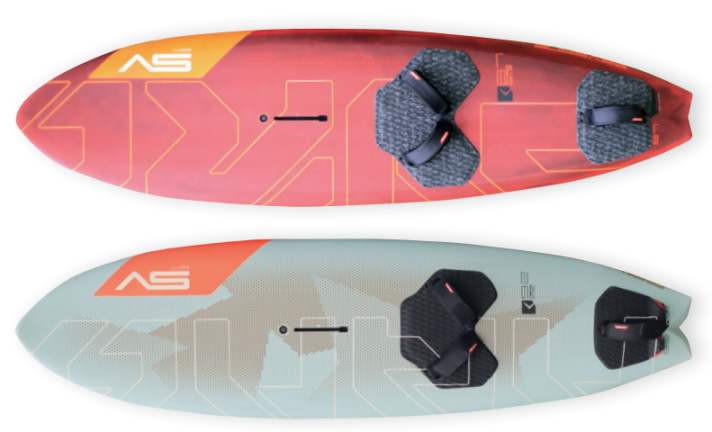
On land
The Pyro is almost a classic and goes into the new season with an unchanged shape, only a new fin setup has been given to the board. Five boxes are installed so that the board can also be ridden as a thruster. The Nano Pro 92, on the other hand, is designed purely as a quad and is even slightly shorter than the Pyro. In addition, the Nano Pro has a distinctive channel in the wide swallowtail and an above-average amount of tail rocker, while the Pyro is significantly flatter in the tail area.
The models also differ in terms of equipment: at least the rear strap of the Pyro is double-bolted. This is not the case with the Nano Pro, and the rear footpad is also very short, meaning that large feet can sometimes land on the edge of the pad.
The Pyro has been given a mono-concave in the underwater hull, while the Nano Pro is characterised by a continuous V, i.e. an implied keel, from front to back. At 6.22 kilos (Pyro) and 5.82 kilos (Nano Pro), the boards are also attractively light.
On the water
In recent years, the Pyro has always set off fireworks when it comes to gliding. How could it be, given the unchanged shape?
However, the new fin setup feels a bit more drag than usual. Nevertheless, the Pyro gets up to speed excellently overall, when powered up the board runs controlled and as if on rails through the roughest conditions. The board also scores points when riding waves with great control on the rail, allowing you to throw yourself mindlessly into the bottom turn without having to worry about the board tilting or even getting bitchy. The shape is best suited to medium radii that are carved at high speed. The Pyro only turns very tightly with a lot of pressure; you certainly won't be able to shake loose snaps out of your ankle with the Pyro.
But can the Nano do more here? When it comes to pure turning, the answer is clearly "yes". It is probably also due to the strong V in the underwater hull that the Nano Pro is easier to rail-to-rail. Tight radii over the back foot are easier with the board, even though it has a few litres more on its ribs. On the other hand, the board also requires more skill in the bottom turn, as it doesn't quite achieve the great carving characteristics of the Pyro. And there's another discipline where the Nano can't keep up with its stablemate: Gliding! Although the board gets up to speed reasonably well, there is a noticeable lack of acceleration and speed, especially in the lower wind range. In our opinion, the tail shape is responsible for this, as the distinctive channels create a noticeable and also visible bubbling when planing and therefore some resistance. This is also the reason why the board runs out of breath a little faster when riding unpressurised waves or with little sail draft.
Severne Waveboards - the conclusion
The Nano Pro is the right choice if you are surfing at a higher level and regularly surf powerful waves or at least well-powered waves. Then the shape can fully utilise its strengths - smooth and variable turning - even if you choose a model one size larger. The Pyro has a much larger target group - strong planing, convincing control and 1-a carving characteristics are good trump cards for a variety of spots. However, because the Pyro doesn't offer the most radical turning characteristics, you can go one size smaller if in doubt.

